Cherry clafoutis, with or without pits?
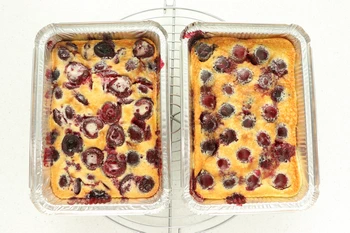
When it comes to cherry clafoutis recipes, there's often a camp of those who argue that you absolutely have to leave the stones in because it tastes better, and the other camp (myself included) who prefer cherries without stones, which makes a much more pleasant clafoutis to eat.
But is it true that cherry pits enhance the taste? Let's find out.
But is it true that cherry pits enhance the taste? Let's find out.
1,496 5/5 (1 reviews)
Keywords for this post:ClafoutisDoughApplianceCherriesPitsTasteExperimentTestKirschComparisonLast modified on: June 29th 2025
Cherry clafoutis, with or without pits?
How to make it?
Making a clafoutis with pits one day, and without pits the next, doesn't really allow you to compare: you'll have more of a memory of the first when you make the second, than of its true taste.The simplest "method" I've found is to make 2 (small) clafoutis with the same recipe, putting pitted cherries in one and pitted cherries in the other, and tasting one then the other, for immediate comparison.
The 2 clafoutis
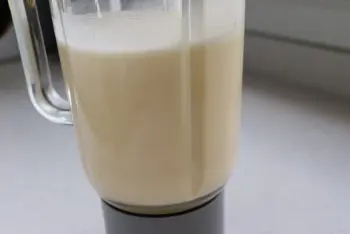
So I made 500g of clafoutis dough, and 600g of washed and dried cherries.
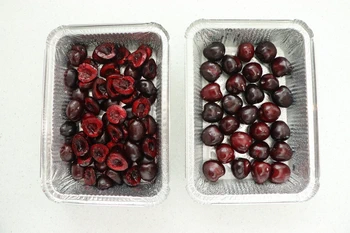
In 2 small molds, I placed the same quantity of whole cherries (300 gr) in one, and pitted cherries in the other.
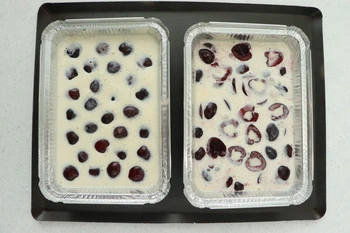
In the 2 molds, I poured the same amount of clafoutis batter (250 gr).

And then off to the oven to bake.
How did it turn out?
We tasted them, lukewarm, and with several people, to try and get different opinions.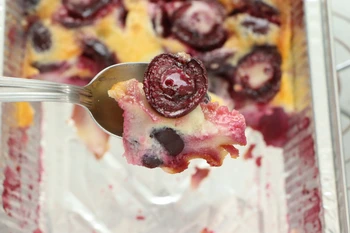
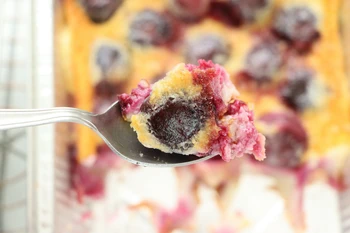
However, we did notice that, in the case of pitted cherries, there's a small, very interesting acidity, which is present in the heart of the whole cherries, and not in the pitted ones.
In fact, I'm afraid we're a little influenced by the color and appearance of the clafoutis: you can see the one with pits, and when you taste it, you think you'll find a difference, which is (in my opinion) a little overrated.
But, as always with taste, there's no arguing with it, and you'll probably have to repeat the experience to make up your own mind.
If you're really looking for that "cherry-stone taste", I'd recommend pouring 1 or 2 tablespoons of Kirsch into the clafoutis batter.
In summary: For cherry clafoutis, leaving or removing the pits during cooking changes the taste very little, if at all.
Lasts posts
Cake moulds
When we make a cake, or a cake of the same rectangular shape, we usually take out our usual mould and tell ourselves that the recipe is anyway "for a cake", but is it really that simple?August 25th 20251,4975
Thinning out herbs
If you need to add a long-stemmed herb (tarragon, mint, verbena, thyme, etc.) to a recipe, you'll probably only need the leaves and not the stem, so you'll need to remove the leaves. Leaf removal means keeping only the beautiful leaves, and eliminating the ugly stems and leaves, but how do you do...August 8th 20251,3445
Add a bay leaf
Bay leaf: small in size, but big in flavor. You'll find it in hundreds of recipes, and it's often added to cooking meat, in a sauce or broth, usually accompanied by other herbs or products. It's a staple of Provençal, Mediterranean and Oriental cuisine, but not the only one. Usually, in a...July 31th 20251,4315
Parsley stems
Parsley, whether curly or flat, is a delicious ingredient in many recipes, where it is used both raw and cooked. When used raw, in a salad for example, where it always provides, alone or with other herbs, a remarkable freshness, only the leaves are kept. And when used cooked?July 28th 20251,577 13
A drizzle of olive oil
Often in a recipe, you have to "baste" vegetables, for example, before sending them to the oven. What the author means by this is that you need to put oil on top of the vegetables to cook them in the oven. Typically, we just quickly drizzle oil over the vegetables, hoping not to miss any, but...July 13th 20251,6905
Other pages you may also like
Cake moulds
When we make a cake, or a cake of the same rectangular shape, we usually take out our usual mould and tell ourselves that the recipe is anyway "for a cake", but is it really that simple?August 25th 20251,4975
85 grams of eggs?
Some time ago, I already spoke to you about the difference between baking and pastry-making, I emphasized, among other things, the precision of pastry-making which requires grams, cm, degrees and minutes. That's why, on the one hand, you have baking and cooking, where a certain tolerance is...November 26th 201852 K4.6
A few tips for effective kneading at home
When you have to knead dough for bread or some other recipe, you may well use a food processor or the type of machine known as a stand mixer. The best-known brands are Kenwood and KitchenAid. They are useful tools, but here are a few tips to help you get the best out of them.June 23th 2021278 K 23.7
The art of the charlotte
In cooking, a charlotte is a delicious moulded dessert, with biscuits around the outside that have been soaked in a flavoured syrup, filled with a light cream or mousse. The charlotte is left to set in the fridge before being turned out and served in slices. It is very light and a lovely sweet...February 27th 201342 K4.3
The window-pane test in bread-making
The home bread-makers often ask themselves “Have I kneaded my dough long enough?” . A good question, as dough that is insufficiently kneaded will not rise properly or will fall flat when the top is slashed, which is very frustrating. To know when the dough is ready, one can rely on the length...June 16th 202192 K 23.9
Post a comment or question
Follow this page
If you are interested in this page, you can "follow" it, by entering your email address here. You will then receive a notification immediately each time the page is modified or a new comment is added. Please note that you will need to confirm this following.
Note: We'll never share your e-mail address with anyone else.
Alternatively: you can subscribe to the mailing list of cooling-ez.com , you will receive a e-mail for each new recipe published on the site.








